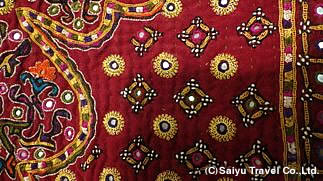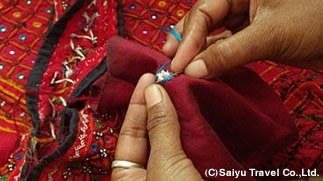| City | Itinerary | |
|---|---|---|
| 1 | (cities in India) |
(From Delhi or cities in India, fly to Ahmedabad, the largest city in Gujarat.) Meals included: Lunch and Dinner | Overnight in Bajana |
| 2 | Bajana Bhuj |
In early morning, drive through the Little Rann of Kutch by a private car to head to Bhuji is the storehouse of handicrafts. Tour the villages near Bhuji. Visit the village of Dhamadka is famous for Ajrak printing, and Bhujdi village is famous for a handloom of wool and mirror works. Also, drop in a shop “Surjan” an NGO operates. Meals included: Breakfast, Lunch and Dinner | Overnight in Bhuj |
| 3 | Bhuj (Banni Area) |
Go to north from Bhuj to head to the Banni Area. In all day, tour the villages are scattered in the Banni Area. The original dyeing and embroidery techniques are continuously succeeded to in each village. (For example, Nirona Village where the techniques of castor-oil processed Rogan painting and tin craft are succeeded to and the village of Mutwa is famous for small mirror of millimeter unit embroidery.) Meals included: Breakfast and Lunch |
| Number of people | Price (INR) |
|---|---|
| 4 | Please contact us. |
| 3 | |
| 2 | |
| 1 | |
| Single room supplement (2 and more people stay in) : Please contact us. | |
** Air tickets can be arranged on request based on best available airfare.
** 5.0% government service tax would be applicable on the prices above.
** The prices above are valid from October 1, 2014 to March 31, 2015.
For other dates, kindly contact us.
** Additional charges would be applicable if you plan your trip during Diwali, Christmas, year-end and New Year holidays. Kindly contact us for best quotes.
Touch with the authentic handicraft in Gujrat continuously succeeds to
Today it may be rare to touch with the authentic handicraft, in the state of Gujrat the various handicrafts are continuously succeeded to. The techniques of embroider and dyeing in this area are the top class in the world and attract the textile funs globally. Go around in the villages of Banni Grasslands, and enjoy the high level culture of dyeing.
The great salt field White Ran
In the Great Rann of Kutch, drop in the pure white great salt field, the White Rann that appears only in the dry season. From the view point, look over to the salt field all over.
We could arrange what you want to do such as experience of handicrafts and buying goods.
It is possible to arrange to extend your stay and to make a textile tour further. We could arrange for the person who wants to experience dyeing and weaving in a village in actual, a group tour, and a buyer to purchase products, and workshops, etc. Please contact us for consulting.
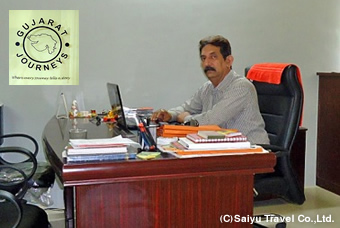
"We will support your trip in Gujarat to the fullest"
Saiyu India has long been established in Ahmedabad since 2003 and has been arranging trips in Gujarat for many years now. All the Gujarat plans are led by Mr. Gautam who plans and executes them and our Ahmedabad branch is at its toes to answer any of its customer's enquiries. We also entertain customized trip requests like trips to textile arts, experiencing the local ethnic lifestyle, visiting the ruins of the Indus civilization and the inspection of companies. Mr Gautam with his extensive experience has made Saiyu India famous in Japan for the "Gujarat journeys".
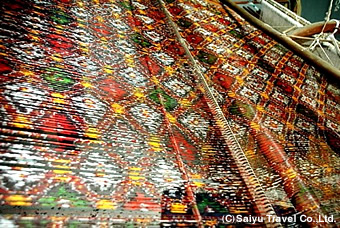 A splashed pattern is popular in Japan such as Ryukyu and Iyo and the origin is India. The splashed pattern woven in India went over to Thailand, Indonesia and Ryukyu. Then, it was spread all over Japan.
A splashed pattern is popular in Japan such as Ryukyu and Iyo and the origin is India. The splashed pattern woven in India went over to Thailand, Indonesia and Ryukyu. Then, it was spread all over Japan.
Among the splashed patterns, Patola is required very high skills to produce. At first, all craftsmen input the final design in their memories. The first process is to die the thread of warp and the thread of woof. Bundling a thin silk thread, and tied by a cotton thread at many places and die, untied and die and continue the processes to die more than 10 colors. A wart thread died up by calculating intricately is set and stretch on the weaving machine, and a woof thread is wound on the shuttle. It is processed by one pair of craftsmen / craftswomen to weave up. The colors of warp thread and woof thread should be matched up by o.1mm. Having matched the colors, the bright color patters are appeared (showed). At present, there is not many people exist who are succeeded in this high skill and it is said only the Salvi family in Patan. Patola is not sold in a market, but it is produced by order made system. One sally costs one car. It is said if a daughter wears a sally made of Patola that Salvi wove at her wedding ceremony, the family’s class becomes higher.
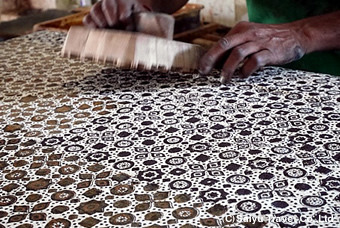 “Ajrak” means “indigo” in Arabic. It origins in the Sindh Province in south Pakistan adjacent to the west of Gujarat. Today, the Muslim producer communities “Katori” are acclaimed for perpetuating the traditional techniques. The process of Ajrak printing is to lay many colors on various hand-carved wood blocks and to dye one piece of cloth. The method is same as printing Ukiyoe in Japan. Dye and mordant are made by iron filings, indigo, turmeric, pomegranate, madder, etc. Many colors are lay to create the black color does not exist in nature. It may be a simple technique at a glance, but combining colors is like a scientific experiment. The souvenir shops in the state of Rajasthan have the similar block prints, but the most of them are made by chemical (synthetic) dyes to stamp by the half tatami mat sized wood-block as mass production. The Ajrak printing works Khatri create by hand attract many people because of comfortable texture.
“Ajrak” means “indigo” in Arabic. It origins in the Sindh Province in south Pakistan adjacent to the west of Gujarat. Today, the Muslim producer communities “Katori” are acclaimed for perpetuating the traditional techniques. The process of Ajrak printing is to lay many colors on various hand-carved wood blocks and to dye one piece of cloth. The method is same as printing Ukiyoe in Japan. Dye and mordant are made by iron filings, indigo, turmeric, pomegranate, madder, etc. Many colors are lay to create the black color does not exist in nature. It may be a simple technique at a glance, but combining colors is like a scientific experiment. The souvenir shops in the state of Rajasthan have the similar block prints, but the most of them are made by chemical (synthetic) dyes to stamp by the half tatami mat sized wood-block as mass production. The Ajrak printing works Khatri create by hand attract many people because of comfortable texture.
